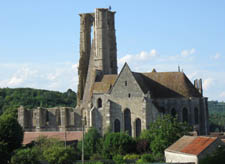Larchant (Seine-et-Marne, France) - Saint-Mathurin
- Disclaimer
The dating found here is based on the work of John James, and is meant on this site to serve as a starting point. James' dating is derived from a system that uses his interpretation of the development of capitals over time as the basis for chronology, among other factors. His goal is to refine the dating to within years rather than decades. I have not fully embraced James' methodology, and will be developing this page from its current state to one which is admittedly more conservative. The relative expenditure values found in the Timeline are also based on James' work, and I believe these to be reasonably reliable. They are intended only to give a sense of the amount of work involved in each decade.
I have added the idea of the "project" as a way of separating work in buildings. In my mind, a "project" is a discrete section of work in a building that resulted from the one-time acquisition of funding. "Projects" are generally separated by at least a decade where no work was being done. It is my view that it would have been unwise to start a "project" that could not be finished and protected from the elements, and as such a "project" usually involved a wing or multiple wings of a building, from floor to roof. Rural churches, which could only secure small amounts of funding at irregular intervals, often were the result of many small projects, while the great churches, which benefitted from relatively consistent funding, may have involved only a few large projects.
I have added the idea of the "project" as a way of separating work in buildings. In my mind, a "project" is a discrete section of work in a building that resulted from the one-time acquisition of funding. "Projects" are generally separated by at least a decade where no work was being done. It is my view that it would have been unwise to start a "project" that could not be finished and protected from the elements, and as such a "project" usually involved a wing or multiple wings of a building, from floor to roof. Rural churches, which could only secure small amounts of funding at irregular intervals, often were the result of many small projects, while the great churches, which benefitted from relatively consistent funding, may have involved only a few large projects.
- Timeline with Relative Expenditure (if available, in building units)
 |
 |
 |
 |
- Project A - 1190s - Phase 1 - apse (b)
A quick job over perhaps a dozen years, starting with apse and eastern transept wall bases and windows, 10 courses that step down at doors.
- Project A - 1190s - Phase 2 - east aisle windows
16 courses probably to the lower window heads, capitals aisle windows with similar designs at all levels
- Project A - 1200s - Phase 3 - w transept (b)
West transept walls with pilasters footings and bases ; not too long after apse as the coursing is together in the clerestory zone
- Project A - 1200s - Phase 4 - east (c)
12 courses to next sills and the clerestory, looks like all these capitals are together from designs, profiles and plan; upper W-n portal for tower built with north wall.
- Project A - 1210s - Phase 5 - east (cw)
East 15 courses to upper window caps and 12 courses to apex of vault.
- Project A - 1210s - Phase 6 - transept (c)
North and south clerestory; east vault could have been completed in this or in the next decade; transept window heads just above.
- Project A - 1220s - Phase 7 - nave (a)
Nave footings and bases from torus profiles, to window sills and capitals; lower 8 courses of porch, iconography very mixed, such as donors in tympanum etc, with the continuous arcade (from the caps) and the use of tori with scotias; nothing more until much later.
- Project B - Later - Phase 8 -
Nave clerestory, upper W-n portal for tower I and II, and porch built with north wall.
- Project B - Later - Phase 9 - .
Upper north nave porch, tower I and II
- Primary Sources for Dating
1176 - LARCHANT
Translation of relics.
Translation of relics.
…together with a verbal account of the translation made in 1176 of the body of said Saint Mathurin to the place where it is now [behind the high altar] by one of his predecessors.
